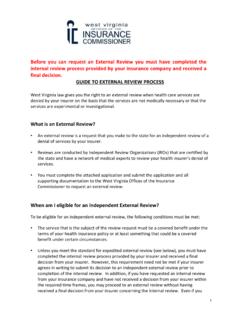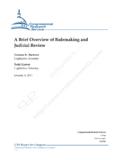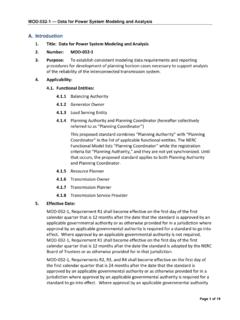Transcription of The process of evidence-based practice in …
1 Used with permission: Australian occupational therapy Journal (2000), 47, 171-180 Feature ArticleThe process of evidence - based practice in occupational therapy : informing clinical decisionsSally Bennett1 and John W. Bennett21 Division of occupational therapy , The University of Queensland, of Social and Preventive Medicine, The University of Queensland, we move into the 21st century, there are increasing demands placed on occupational therapists to ensure their practice is based on sound evidence . evidence - based practice is an approach to clinical decision making that has gained considerable interest and influence during the last decade. This article describes and explains the process of evidence - based practice and its application to clinical occupational therapy practice . Directions for resources that may assist therapists' self-directed learning are also provided. As health care becomes more evidence - based , awareness of the principles, skills, and resources for evidence - based practice is of relevance to all occupational Words clinical decision making, evidence - based is an electronic version of an article published in the Australian occupational therapy Journal:Bennett, S.
2 & Bennett (2000). The process of evidence - based practice in occupational therapy : informing clinical decisions. Australian occupational therapy Journal, 47, is published in the print edition of the Australian occupational therapy Journaland is available on the Blackwell Synergy online delivery service, accessible via the journal's website at: or :Sally Bennett Department of occupational therapy , School of Health and Rehabilitation Sciences, The University of Queensland, Queensland 4072, Australia. Email: for publication August 2000 INTRODUCTIONThe demand for maximum quality of care, combined with the need for prudent use of resources has increased pressure on health care professionals to ensure that clinical practice is based on sound evidence . Changes in treatments, an exponentially increasing volume of research information, and increasing expectations from clients to provide the best care possible, place high demands on therapists to maintain a service that is based on current best article outlines the process of evidence - based practice as a means for informing the clinical decisions made by occupational phrase ' evidence - based medicine' originated in the 1980s as a way of describing Used with permission: Australian occupational therapy Journal (2000), 47, 171-180 the problem- based learning approach initiated at McMaster University medical school (Bennett, Sackett, Haynes, Neufeld, Tugwell & Roberts, 1987).
3 ' evidence - based practice ' and ' evidence - based health care' are phrases that have since been used to represent the concepts and principles encompassed by evidence - based medicine, but are applicable to the broader health care context. evidence - based practice has been defined as 'the conscientious, explicit, and judicious use of current best evidence in making decisions about the care of individual patients' (Sackett, Rosenberg, Gray, Haynes & Richardson, 1996; p. 7). It has been described as a process that synthesizes clinical expertise, with the best evidence available from systematic research, and the values and preferences of patients. Sackett, Richardson, Rosenberg and Haynes (1997) emphasized that it should build on and reinforce, but not replace, clinical judgement and experience. In this sense, research evidence is just one factor informing clinical decision making.
4 A FRAMEWORK FOR evidence - based occupational therapy PRACTICEThe process of evidence - based practice is essentially the same for occupational therapy as for other health disciplines. However, some differences in its application arise from the differing practice domains and theoretical models used. A framework for the use of evidence - based practice in occupational therapy is presented in Fig. 1, drawing on concepts presented by Bennett and Glasziou (1997), Law et al. (1996), and Sackett, Richardson, Rosenberg & Haynes, (1997). This framework presents evidence - based practice as a process that follows a cycle stemming from clinical decisions that need to be made in all stages of the occupational therapy treatment process . clinical questions are identified that reflect the information needed to make clinical decisions, and which take into account the specific client or group of clients being treated, as well as the context in which treatment occurs.
5 Figure 1. A framework for evidence - based occupational therapy with permission: Australian occupational therapy Journal (2000), 47, 171-180 A literature search is undertaken to identify the best research evidence available to answer the question. As not all studies are well performed, a critical appraisal of the article for its validity and clinical usefulness is important. Perhaps the most crucial aspect of the evidence - based practice process is the use of evidence with the client. clinical reasoning is used to determine whether the evidence 'fits' with each feature of the client's context (person, occupation and environment). Particular attention should be given to the preferences and values of the client. Consideration must also be given to the practice setting, clinical expertise, and resources available to the therapist. Clients, and where appropriate families or carers, are actively engaged in the decision making process to determine the action to be taken.
6 Although not represented in the framework, evaluation of this process is undertaken to determine improvement in relevant outcomes and to identify factors that will make the process more efficient (Sackett et al., 1997). ASKING clinical QUESTIONST ypes of questionsThere are many times that new information is required when seeing clients in order to resolve clinical problems and make treatment decisions. These questions may relate to a specific client or groups of clients. The types of questions that arise reflect the core clinical tasks of occupational therapy practice . Categories of clinical questions classified by proponents of evidence - based medicine include, but are not limited to, questions concerning diagnosis, treatment/prevention, and prognosis (Sackett et al., 1997). There is some debate over the relevance of these categories to occupational therapy practice (Egan, Dubouloz, von Zweck, & Vallerand, 1998).
7 While these are not always the common labels occupational therapists use to describe elements of practice they are, by and large, still applicable to occupational therapy practice . Questions commonly emerge concerning the effectiveness and choices of occupational therapy treatments, how treatments are best implemented, and whether there are any associated difficulties. Research evidence can also be used to answer 'prognostic' questions, such as what the likely clinical course, complications, or consequences of a disease, injury or disability may be. occupational therapists can use this sort of research evidence to help clients understand, plan and cope with their concerning diagnosis are also relevant for occupational therapists although there are significant conceptual differences to traditional medical diagnosis.
8 Rogers and Holm (1991) refer to an occupational therapy diagnosis as a problem statement that describes occupational status deficits amenable to therapy . Rather than arriving at a label or classification of a disease, as is often the case in medicine, occupational therapists identify deficits in performance components, occupational performance or role performance. Therapists use a range of assessment processes to arrive at an occupational therapy diagnosis including history taking, physical examination and standardized assessment tools. Many questions concerning diagnosis can be answered by dialogue with the client, observation and clinical reasoning. However, there are other diagnostic questions that may be answered by evidence from research that has been performed with similar groups of patients or clients.
9 Such questions include what the most likely occupational diagnoses might be for clients presenting with a particular constellation of problems, or which assessment measures have the highest accuracy. Used with permission: Australian occupational therapy Journal (2000), 47, 171-180 Questions about what the most common occupational issues are likely to be for specific client populations can be informed by descriptive research, and knowing what the likely concerns or experiences clients may have can be answered by qualitative and descriptive research ( Tickle-Degnen, 1999). Although the emphasis of this paper is on the use of evidence - based practice in clinical care, therapists also participate in questions of a non- clinical nature, such as economic or policy issues. Examples of clinical questions relevant to occupational therapy are provided in Table 1.
10 Discussion about what 'categories' of clinical questions are most relevant and reflect the core clinical tasks of occupational therapy practice may help to clarify the process further. Question formationWhen there is a knowledge gap or uncertainty, the need for information can be converted into a clinical question. Explicitly framing a question not only clarifies what to focus on, but it can also expedite the search for answers. Sackett et al. (1997) point out that the identification of relevant information for answering a particular clinical question may be facilitated by breaking the question into components including: 1. A client or a problem being A treatment or indicator being An outcome or outcomes of interest you would like to measure or A comparison (where relevant).For example, if a therapist was interested in the effectiveness of cognitive behaviour therapy with patients with chronic fatigue syndrome, the question could be phrased:'Does cognitive behaviour therapy (intervention) improve function (outcomes) in adults with chronic fatigue syndrome (client) compared with standard care?








